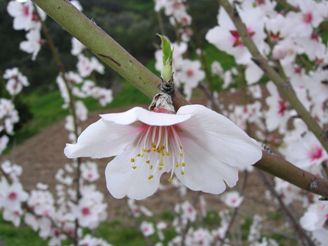Reproduction

Prunus dulcis is not a self-pollinating plant. The flowers of the plant require insects, such as honey-bees, to carry and transfer the pollen to other flowers for cross-fertilization. In almond orchards, cultivators plant alternating rows of variety for the cross-fertilization.
 The
flowers of the Prunus dulcis plant are hermaphroditic,
meaning that they contain both female and male reproducing
organs. When another organism is pollinating a flower with
the pollen from a different flower, the pollen which produces
the sperm must come in contact with the ovule (which contains
the egg) in order for the production of a seed to occur.
The
flowers of the Prunus dulcis plant are hermaphroditic,
meaning that they contain both female and male reproducing
organs. When another organism is pollinating a flower with
the pollen from a different flower, the pollen which produces
the sperm must come in contact with the ovule (which contains
the egg) in order for the production of a seed to occur.
The life-cycle Prunus dulcis goes through is called the alternation of generations. Alternation of generations is a complex life-cycle. The almond tree is sporophyte dominant, it undergoes meiosis to become haploid spores which are then gametophyte until they fertilize and become a zygote. The zygotes then undergo mitosis and are in their dominant form, sporophyte.
Most Prunus dulcis trees do not bear fruit until they are about 3-4 years old. The almond trees begin to bloom and flower around March, are pollinated, and begin to have ripening fruit around October.
Move along to gain more knowledge on the almonds social status
